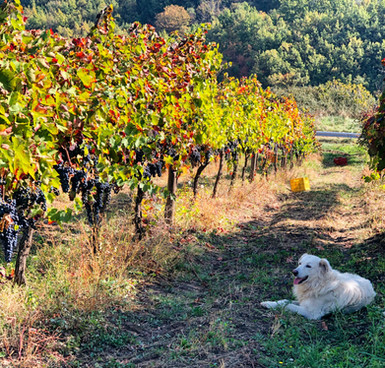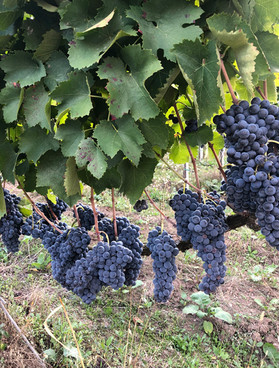Irpinia Tasting Notes: Irpinia Aglianico
- Sarah Pompei
- Apr 26, 2023
- 4 min read
The first question I normally get when I’m talking about Irpinian wines (well, after I get confused looks and the question: Where exactly is Irpinia within Italy, even from Italians) is what is the Irpinia Aglianico grape? Everyone’s looking for a leveling point from a wine they know. Is it like a big Napa Cab? Is it like the Bordeauxs or Burgundies of France? Or maybe is it more similar to a Chianti Classico or Super Tuscan from Tuscany or a Barolo or Barbaresco from the Nebbiolo grapes of Piemonte (Piedmont)?
If you’re scratching your head, you’re not alone. Even some Somms and those entrenched in the wine world I’ve met don’t know this grape varietal. I certainly had never heard of Irpinia Aglianico or Taurasi before the first time I set foot in Irpinia. But when I took that first sip of the wines made from this indigenous grape, I felt the pitter patter of my heart doing a dance in response to the big bold flavors in my mouth and I knew I was in love. This was the red wine I’d been waiting for my whole life. I’d take this over a prince at the end of the fairytale anyday.

The truth of the matter is that while Irpinia Aglianico is the foundation for some absolutely stunning wines, it is by no means an “easy grape” to make drinkable wines from. It’s a grape defined by huge tannins, big acidity, and strong flavors when it’s well crafted into the region’s stunning wines. Right off the vine, it’s full of a delicious acidity, and when you bite down into the crunch of the skins from these grapes, you can tell incredible wines will be produced from the fruit in the hands of an artisanal winemaker. Of course this is in spite of the seemingly impossible task of harnessing the traditional characteristics of the Aglianico grape and refining them into an enjoyably drinkable wine.
Giovanni Fiorentino of Azienda Agricola Fiorentino once told me the grape is at its core a mean grape, a tough grape, almost like a spoiled child, that needs to be taught the manners of polite company. It made me giggle because I instantly knew what he meant without ever having the bravery to even think of crafting wines myself. It’s as if a winemaker isn’t careful, and if they aren’t crafting wines with respect, knowledge and passion, that spoiled brat of a grape will kick you right in the shins.
Yes Irpinia Aglianico has beautiful notes of red forest berries, dark amarena cherries, and depending on where your grapes were grown and how long it’s been awaiting your opening the bottle, maybe you’ll have some nice notes of tobacco too. It can be velvety and smooth, yet when made well, this wine retains the strong body and structure of the grape letting you know from first sip, this is no wimp of a wine.

You won’t often taste the influence of new wood (smoke, vanilla, etc) from the barrels the Irpinia Aglianico is aged in as most producers here in Irpinia prefer the grape to stand on its own legs (couldn’t help myself with that one). For such a strong grape, when made right, it’s immensely enjoyable to drink on its own if you love big wines, and if you don’t, a little piece of Italian cheese or some salumi will help guide you to wine bliss.
The history of these Irpinia Aglianico wines goes back to ancient times when the Greek and Roman Empires were at their pinnacle. You can read how the Greeks brought the Aglianico grape to Southern Italy thousands of years ago where it served as the wine of gods and men alike. During this time and beyond, the superiority of Campania Aglianicos have been widely celebrated. The volcanic clay soils of the Campania region, home to Mount Vesuvius, provided perfect growing conditions for the Aglianico vines from the coast of Naples all the way to the mountains of Irpinia.
If you’re wondering why I’m so insistent on calling this grape varietal Irpinia Aglianico instead of just Aglianico, here’s why: there’s an immense difference in the flavors and structures in the Aglianico grapes grown in Irpinia when compared to the other Campania Aglianicos. Why is this? One of the main differentiators can be attributed to the higher mountain altitudes of the Irpinia region, and the warm summer days and cool nights of Irpinia make for a uniquely distinct Aglianico when compared to others from Campania like those grown in and around Pompei, Paestum, Caserta, or Naples.
It’s almost as if the colder Irpinia evenings give the region’s wines an edge over the warmer climates that also produce Aglianico wine within Campania’s borders. Maybe it’s the way the wind whips through the hillsides at night, cooling the vines that crawl hundreds of meters down sloping hills that provide the conditions to produce such magical wines.

But even within each region of Irpinia, there exists a distinct difference in the flavors and structures of the Aglianico grapes when you’re tasting the wines. Paternopoli, Montemarano, Castelfranci, Taurasi, on and on, all have their own little signature due to the unique terroirs that exist even as few as a feet from each other across the region.
So what are the differences between these Irpinia regions and what are the wines made from the Irpinia Aglianico grape? I’m glad you asked.
When it comes to the Irpinia Aglianico grape itself, the grape can be crafted into a variety of wines: Irpinia Aglianico, Campi Taurasini, and the most known Aglianico wine, the DOCG Taurasi. Stay tuned for a deeper dive into these various Irpinia Aglianico wines coming soon, or send me a note and I’ll be happy to answer questions.
And of course, here’s a shameless plug for you to come visit us in person in Irpinia as soon as it’s possible. Because, no joke, nothing will help you learn these wines better than coming for an in person visit! Second best, drink the wines of the region at every turn. So until you can get on a plane and make the best decision you’ll have made in a long while to come visit us in person, call Schneiders or send me a message to order a few bottles direct to your door.

















Comments